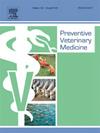伊朗荷斯坦奶牛因口蹄疫造成的生产力、繁殖和经济损失
IF 2.2
2区 农林科学
Q1 VETERINARY SCIENCES
引用次数: 0
摘要
本回顾性研究调查了口蹄疫(FMD)对伊朗荷斯坦奶牛生产和繁殖性状、经济损失和扑杀趋势的影响。研究人员对来自几个省份的9个工业和半工业奶牛群的数据进行了十多年(2009-2019年)的分析,其中包括来自20,330头奶牛的49,400条记录。采用混合线性模型评估口蹄疫对产奶量、脂肪和蛋白质产量以及繁殖性状的影响。利用模拟生物经济模型估算口蹄疫对生产性状和生殖性状造成的经济损失。该模型包括由于产奶量减少、丢弃的牛奶、繁殖效率低下、发病率、扑杀和替换动物、体重损失、疫苗接种、药物和补充成本以及劳动力成本造成的损失。口蹄疫显著降低了产奶量,每头奶牛平均减少845.9 kg脂肪校正乳(FCM),脂肪产量减少44.1 kg,蛋白质产量减少2.3 kg。产犊间隔(+30.9 d)、开胎天数(+13.7 d)、授精次数(+0.2倍)和妊娠期(+1 d)均对繁殖性能产生负面影响。经济分析显示,每例口蹄疫的平均损失为1082.3美元,其中最高的损失可归因于扑杀和替换动物(27. %,296.2美元)和繁殖效率低下(22. %,239.6美元)。这些结果对控制口蹄疫传播的农场管理策略和计划预防措施以减少经济损失具有重要意义。本文章由计算机程序翻译,如有差异,请以英文原文为准。
Productivity, reproduction and economic losses due to foot-and-mouth disease (FMD) in Iranian Holstein cows
This retrospective study investigated the impact of foot-and-mouth disease (FMD) on productive and reproductive traits, economic losses and culling trends in Holstein cows in Iran. Data from nine industrial and semi-industrial dairy herds from several provinces were analyzed over a decade (2009–2019) and included a total of 49,400 records from 20,330 cows. A mixed linear model was used to assess the impact of FMD on milk production, fat and protein yields and reproductive traits. Information on milk production was collected over a period of 305 d. A simulated bioeconomic model was used to estimate the financial losses due to FMD incidence on productive and reproductive traits. The model included losses due to reduced milk production, discarded milk, reproductive inefficiency, morbidity, culling and replacement animals, loss of body weight, vaccination, medication and supplementation costs, and labor costs. FMD significantly reduced milk production, with an average decrease of 845.9 kg of fat corrected milk (FCM) per cow, a decrease of 44.1 kg in fat yield and a decrease of 2.3 kg in protein yield. Reproductive performance was negatively affected, with an increase in calving interval (+30.9 day), days open (+13.7 day), number of inseminations (+0.2-fold) and length of gestation (+1 day). Economic analysis showed an average loss of $1082.3 per FMD case, with the highest costs attributable to culling and replacement of animals (27 %, $296.2) and reproductive inefficiency (22 %, $239.6). These results have significant implications for farm management strategies to control the spread of FMD and to plan preventative measures to reduce economic losses.
求助全文
通过发布文献求助,成功后即可免费获取论文全文。
去求助
来源期刊

Preventive veterinary medicine
农林科学-兽医学
CiteScore
5.60
自引率
7.70%
发文量
184
审稿时长
3 months
期刊介绍:
Preventive Veterinary Medicine is one of the leading international resources for scientific reports on animal health programs and preventive veterinary medicine. The journal follows the guidelines for standardizing and strengthening the reporting of biomedical research which are available from the CONSORT, MOOSE, PRISMA, REFLECT, STARD, and STROBE statements. The journal focuses on:
Epidemiology of health events relevant to domestic and wild animals;
Economic impacts of epidemic and endemic animal and zoonotic diseases;
Latest methods and approaches in veterinary epidemiology;
Disease and infection control or eradication measures;
The "One Health" concept and the relationships between veterinary medicine, human health, animal-production systems, and the environment;
Development of new techniques in surveillance systems and diagnosis;
Evaluation and control of diseases in animal populations.
 求助内容:
求助内容: 应助结果提醒方式:
应助结果提醒方式:


